IN maximum configuration and with manual transmissions is only a hundred rubles, but in addition to the meager difference in price, there is also a huge difference in time. What should the buyer prefer - the market newcomer Sandero or the time-tested Rio?
The debate over which is better, Sandero or Rio, is actually topical. Type “Rio or Sandero” in any of the search engines, and dozens of pages will appear in front of you, on which adherents of the first or second model will prove the superiority of their car over another. Moreover, these will be both specialized forums and forums that are completely far from automotive topics. In particular, on one of the sites we happened to see a dispute on this topic among cactus growers. In general, even botanists argue. We decided not to argue, but to really see which of the cars is really better. Twenty minutes of calling dealers, and the next day two top-of-the-line hatchbacks were at the meeting point. Both with manual transmissions, both with the highest possible power motors and both with puddles on the pavement in the engine area. The unbearable July heat, which covered even the northern regions of our vast country this year, did not allow us to turn off the air conditioners in cars for a minute. Result: condensate from kondeev poured on the asphalt like a river from under both cars. However, here the first differences appeared.
Let's start with the fact that the Sandero has air conditioning, and the Rio has climate control, and even if it is not two-zone, but when electronics monitor the optimal temperature in the cabin, it is still more pleasant. And the very operation of the air conditioner on Rio practically does not affect the overall noise of the engine, both in the cabin and from the street. As soon as you press the corresponding button on the center console in Sandero, as sparrows bathing in a puddle that has not dried up after yesterday's downpour, they immediately take off. The noise of the radiator fan in such modes is quite strong. In the cabin, everything was still all right, but outside the car was noisy, like a Progress rocket before launch. It is worth turning off the air conditioner, as grace descends on the world again. In general, either the French were playing it safe, or they didn’t calculate something there to the end, but the fact remains: the air conditioner seriously affects the overall noise background from the operation of the Sandero engine, and this is not very good.
But they succeeded in calculating the useful volume of the luggage compartment. Like it or not, the Sandero's 320 liters of luggage space will always be more than the Rio's 270 liters of luggage space. However, the volume is volume, and the convenience of using the trunk itself is also an important point. To begin with, the Sandero has a significantly higher loading height than the Rio. The second moment: it will not be difficult to secure the load in the trunk of the Rio, there are corresponding loops in the floor, but the Sandero does not have them. And thirdly, despite the fact that the trunk in Rio is smaller, the opening itself is wider in width. Why the designers of Sandero artificially narrowed it due to the unjustifiably protruding guides of the luggage compartment shelf remained a mystery to us. However, it is not without drawbacks and trunk Rio. One has only to fold the backs of the second row, as you understand that a more even cargo area is still obtained in the Sandero. Yes, and one third, which can not be folded in favor of the third passenger, is still more for the “Frenchman”, which, however, is understandable, because it is wider.
However, with the front seats fully retracted, it is more comfortable to sit in the Rio. There are special recesses in the backs of the front seats of the "Korean". And unlike the Sandero's exactly the same notches, they have a plastic base. That is, massage with the knees of the rear passengers does not threaten either the driver or the front passenger in Rio. In Sandero, a long-legged driver or his neighbor will have to be patient. Any movement of the person sitting behind you literally feels like a liver. But what grace in both cars in front! Enough space for even the most lanky. In any case, with a height of 185 cm, the legs of the front passenger can be fully extended. The driver does not feel deprived either. Both in Sandero and Rio, he can also get comfortable behind the wheel. Both cars have the same seat and steering wheel adjustments, and therefore they are almost identical in this indicator. The little things are only in ergonomics. And although it is almost the same for the “Korean” and the “Frenchman”, there are still differences. So, the horn button for the "Korean" is located in the center of the steering wheel, and for the "Frenchman" at the end of the left stalk. Or take the Sandero mirror adjustment. It is located between the front seats, and for Rio it is on the driver's door. Little things, of course, but they take getting used to.
What you definitely have to get used to is the weightless clutch pedals, both on the first and on the second car. Initially, it seems that there is nothing at all on the other end of the cable. Is it correct? Perhaps someone will brag about this, but such excessive lightness seemed inappropriate to us.
Sensuality, as they say, disappears, and you have to work with the clutch pedal literally intuitively. I thought a little, and either stalled or jerked off with a crank. In general, it's stressful. The same can be said about the power steering, but, however, only in Rio. The “Korean” has it electric, and therefore it is excessively light in parking mode and prohibitively heavy in track mode. Moreover, at high speed from scratch, it literally has to be turned off. He turned - and went too far, which means an extra movement in reverse side to correct the trajectory. Sandero in this case is more predictable, however, that when parking, that at high speed, the force on the steering wheel is the same - it is moderately heavy. What about dynamics? Unfortunately, our market Rio comes with a single engine. This is a 1.4-liter in-line 16-valve 97-horsepower power unit. Sandero is more democratic, and as many as three engines are offered to the buyer to choose from. But for the money that we announced at the beginning of the article, Renault boasts a motor with a large volume and more power. Here we are talking about 1.6 liters of volume and 102 liters. from.
In Europe, this hatchback appeared two years ago. And, interestingly, there it costs less than a co-platform Renault Logan, we have the opposite. Apparently, in this way the company's marketers are trying to give the car a slightly different status. Unlike Logan, in their opinion, Sandero gravitates more towards young people than to those who are in favor.
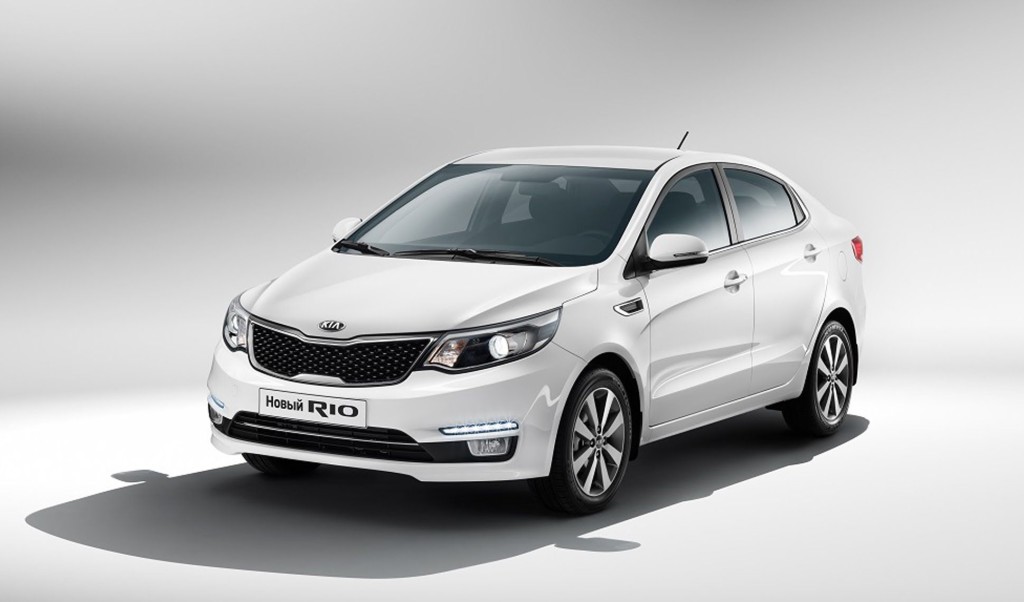
Driving
The maximum torque is shifted to the area high speed, in connection with which the motor has to be spurred all the time.
Salon
Spacious enough. The trunk is roomy.

Comfort
The efficiency of the air conditioner in hot weather cannot but rejoice.
Security
There is only one airbag in the base. The second pillow and ABS are an option even in the maximum configuration.
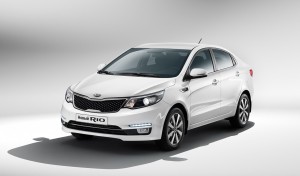
Price
Interesting, but could well be even more competitive.
This car is not new to our market, and therefore there is a well-established demand for it. Nevertheless, the manufacturer now and then modifies his bestseller so as not to lose customers. The last change is restyling, which pulled Rio to the general corporate style and thus again stirred up interest in the model.

Driving
The dynamics of the car is quite acceptable. Do not cause negativity and brakes, however steering takes getting used to.
Salon
Moderately spacious, comfortable enough. Materials that seem soft to the touch turn out to be hard plastic.
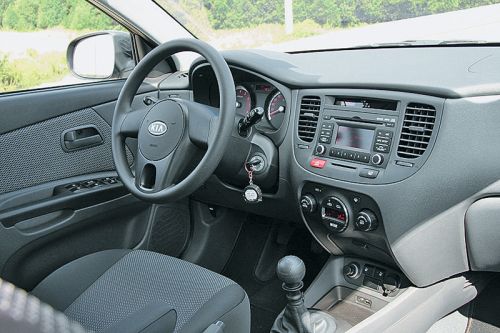
Comfort
Climate control and an audio system can brighten up even the longest trip.
Security
Two airbags and ABS - quite comparable to the price of the car.

Price
Quite appropriate for the car.
Our verdict
So what's the bottom line? Who has won? We would definitely not answer this question. For example, we have not been able to answer for ourselves the question of which car is actually more dynamic. Those two seconds of the difference that are declared by the manufacturers did not particularly strike us in the acceleration to a hundred. And in other respects, the cars are very similar. Both Sandero and RIO have their pros and cons. And disputes, so they are disputes, so that truth is born in them. We just tried to prioritize and thus added oil to the fire.
Scriptio: Oleg Kalaushin.
Budget hatchbacks are getting more and more popular. Russian market, since they are inexpensive, they usually look quite solid and at the same time are able to perform all the necessary tasks. The heroes of our today's review are two competitors - Renault Sandero and Kia Rio. Which of the cars is better, which are strong and weak sides they have? french car looks more simple, but its owners unanimously claim that it is super practical. The Korean has a modern and stylish appearance, won't that prevent him from being a good "workhorse"? Today we will try to compare and make a verdict on which of the cars is still better and deserves more attention.
Power units
Renault Sandero is offered with 3 different engines:
- 1.2 liters (75 hp).
- 1.6 liters (82 hp).
- 1.6 liters (102 hp).
The first option is a gasoline injector that produces 107 Nm and is able to accelerate the car to hundreds in 15 seconds. This unit is frankly weak and is suitable either for those who like a quiet ride, or for people with a very limited budget. At the same time, in the average mode, he “eats” about 7.5 liters of 92 gasoline.
The second option has slightly more power and is now capable of reaching 60 mph in 12 seconds. A significant drawback of this engine is fuel consumption - about 10 liters of 92 fuel in the city. Immodest appetites, as it seems to us.
 The most powerful motor is capable of delivering 102 "horses" and 145 Nm, which allows you to accelerate to a hundred in 10.5 seconds. However, this engine, like previous versions, has a high fuel consumption - about 10 liters in the city.
The most powerful motor is capable of delivering 102 "horses" and 145 Nm, which allows you to accelerate to a hundred in 10.5 seconds. However, this engine, like previous versions, has a high fuel consumption - about 10 liters in the city.
Kia Rio is offered with only two engines:
- 1. 1.4 liters (107 hp).
- 2. 1.6 liters (123 hp).
The first engine is quite simple and is capable of delivering 135 Nm. Despite the fact that the power is the same as that of the Sandero, it is noticeably slower than the Frenchman and goes up to a hundred a second longer. but maximum speed higher, and consumption is only 7.5 liters of the same 92 gasoline.
The 1.6-liter engine with a power of 123 hp (155 Nm) is already much more dynamic, while it does not have such appetites as the Sandero. It accelerates to a hundred in a little more than 10 seconds and at the same time consumes an average of 8-8.5 liters in the city.
In general, of course, the Kia Rio has better and more economical engines, but at the same time they are much more expensive. The maximum engine on a Renault Sandero costs the same as the minimum on a Korean. Therefore, if you do not take into account the price, then the Korean is clearly better, but the French is more affordable.
Transmission
 Renault Sandero offers its owners only one gearbox - a 5-speed manual. Of course, this is a disadvantage, since automatic transmission is much more convenient. However, given the engines used in the French, we can say that the machine is not needed here. Furthermore, mechanical box more reliable and trouble-free, and its cost is much lower.
Renault Sandero offers its owners only one gearbox - a 5-speed manual. Of course, this is a disadvantage, since automatic transmission is much more convenient. However, given the engines used in the French, we can say that the machine is not needed here. Furthermore, mechanical box more reliable and trouble-free, and its cost is much lower.
The Kia company in this regard is much more generous to its future owners. Each of power units on Rio it can be equipped with two different checkpoints. For example, for the 1.4 liter version, a 5-speed manual or a 4-speed automatic is provided. The first option has shown its reliability over the years of use, as the switching is clear, without knocking out and other problems. The machine also pleases, the change of speed is imperceptible, but it is not suitable for dynamic driving.
 The Kia Rio version with a 1.6-liter engine can have either an automatic transmission or a manual transmission, both of which will have 6 speeds. In general, there are also no complaints about them, but there is an opinion that it makes no sense to put a 6-speed box on an engine with 123 horsepower. This results in each gear being too short, which already affects the dynamics of the car. But a serious and important advantage of such units is that they are economical.
The Kia Rio version with a 1.6-liter engine can have either an automatic transmission or a manual transmission, both of which will have 6 speeds. In general, there are also no complaints about them, but there is an opinion that it makes no sense to put a 6-speed box on an engine with 123 horsepower. This results in each gear being too short, which already affects the dynamics of the car. But a serious and important advantage of such units is that they are economical.
So, in terms of transmission, the Kia Rio is the clear leader, because 4 different gearbox options can be installed on it, while there is no choice at all on the Renault Sandero.
Salon (interior)
 As for this parameter, it is already becoming more difficult to compare cars, since both the Kia Rio and the Renault Sandero are quite nice inside and well-designed in terms of ergonomics.
As for this parameter, it is already becoming more difficult to compare cars, since both the Kia Rio and the Renault Sandero are quite nice inside and well-designed in terms of ergonomics.
The previous generation of Sandero had a frankly unsuccessful and boring interior, which cannot be said about new body. The interior has nothing to repel - a comfortable steering wheel, an informative and clear instrument panel, which is perfectly visible at any time of the day. In addition, the center console is also made very high quality, and glossy plastic in the top configuration looks completely rich. The seats are unexpectedly comfortable, and the lateral support holds up well during sharp turns and other maneuvers. The back seat will comfortably accommodate two, while the three of us will be a little cramped.
Salon at Kia Rio is more modern and beautiful. There is nothing to complain about here - a beautiful and bright tidy, a comfortable console, a pleasant steering wheel, comfortable seats with a chic profile. As for the space for rear passengers, the situation here is the same as that of Sandero.
It is impossible to say unequivocally that the interior of a particular car is better. Kia is perfect for young people who want something unusual and beautiful. Sandero will be preferred by more conservative and adult drivers, since the interior is more strict. But they are both comfortable and pleasant in terms of the quality of the materials. Therefore, there is a draw here, both cars are good!
Appearance (exterior)
The appearance of the car for most people plays an important role, so companies are trying to make their car as attractive as possible. Kia Rio looks chic without exaggeration, it is clear that the designers have tried. Sharp lines, bold and rims, LED headlights - all this gives the Korean an aggressive look that immediately attracts attention. This is probably one of the most beautiful budget cars among all competitors.
Renault Sandero has a simpler and more classic look. The rear roof is almost square and has only a slight understatement. Also, small headlights and a conventional grille do not add originality to this car. At the back, the Frenchman is more attractive, as the bumper and trunk lid look really good.
It is easy to compare Kia Rio and Renault Sandero in appearance. The clear winner will be the stylish and fresh Rio, especially after the last restyling in 2015.
capacity
 For budget car is an extremely important indicator, since it is, as a rule, the only car in the family, which is used not only in the city, but also for trips to the country, the sea, etc. That is, there are enough situations when you need to transport a large number of things.
For budget car is an extremely important indicator, since it is, as a rule, the only car in the family, which is used not only in the city, but also for trips to the country, the sea, etc. That is, there are enough situations when you need to transport a large number of things.
Renault Sandero, in its ability to transport goods, is not inferior to some cars with more serious dimensions. Volume luggage compartment is 320 liters, which is quite good for a hatchback. This place is usually enough to put all the most necessary things and hit the road. Furthermore, rear seats can be folded without problems, because they fall in a ratio of 60 to 40. When the backs are folded (this can be done in a maximum of 10 seconds), an incredible space of 1.2 cubic meters is formed, which can be used to transport any goods. However, the disadvantage of Sandero is that when the seats are folded down, a flat floor is not formed, and this is not very convenient. Furthermore, rear bumper does not have special plastic pads, so it will not be difficult to scratch it, which requires increased attention when loading solid objects.
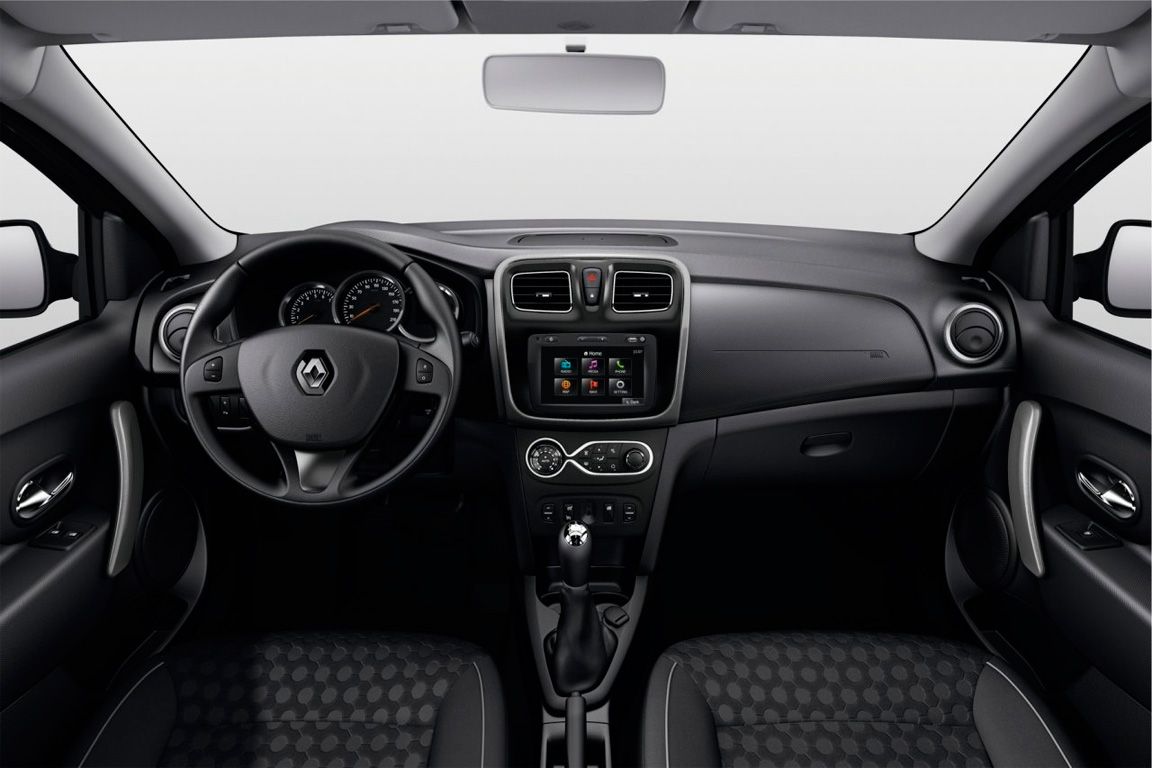 It is quite obvious that the Kia Rio has a small luggage compartment. However, in reality, it turns out to be even more modest than it might seem - the volume of space is only 220 liters. In some situations, you can fold the rear seats, which will allow you to get a volume of 923 liters. But even in this case, it is almost 300 liters less than the rival Renault Sandero. A step is also formed here and you should not dream of a flat field. Moreover, given the small size tailgate, the possibility of transporting some oversized cargo on the Kia Rio is a big question. Therefore, we can safely say that a Korean is a car for the city that will take you from home to work, to a store or other business, but even a trip for some household appliances can cause problems.
It is quite obvious that the Kia Rio has a small luggage compartment. However, in reality, it turns out to be even more modest than it might seem - the volume of space is only 220 liters. In some situations, you can fold the rear seats, which will allow you to get a volume of 923 liters. But even in this case, it is almost 300 liters less than the rival Renault Sandero. A step is also formed here and you should not dream of a flat field. Moreover, given the small size tailgate, the possibility of transporting some oversized cargo on the Kia Rio is a big question. Therefore, we can safely say that a Korean is a car for the city that will take you from home to work, to a store or other business, but even a trip for some household appliances can cause problems.
Obviously, Renault Sandero is better than the competitor in terms of roominess, so if you need a car for work, then it is clearly preferable!
Suspension
Drivers Kia car Rio quite often complain that chassis too harsh even during normal traffic on average quality roads in the city. More serious problems start on poor pavement when driving on country roads. Firstly, the cabin starts to make noise and creak, although it is usually quite quiet. Secondly, passengers feel even minor blows on themselves and comfortable seats do not save in any way.
But, despite these shortcomings, it copes well with the stability of the car at any speed. In its class, this is one of the most driving cars, because when cornering, the rolls are minimal and, in general, the behavior on the road is pretty good. Also, when making maneuvers, the car does not sway, and therefore you can not be afraid of a dynamic ride. Such is the price for comfort when buying Rio, you need to be prepared for this.
The confrontation between French and Korean cars continues, and in today's article we will Kia comparison Rio and Renault Sandero, as a result of which we will choose which is better. Both models are in great demand in the Russian market and consistently enter the TOP of the best-selling.
History
Kia Rio debuted at the beginning of the new millennium. Analysts immediately began to predict a great future for the new product, and most of these predictions came true. Initially, Rio was offered in sedan and station wagon bodies.
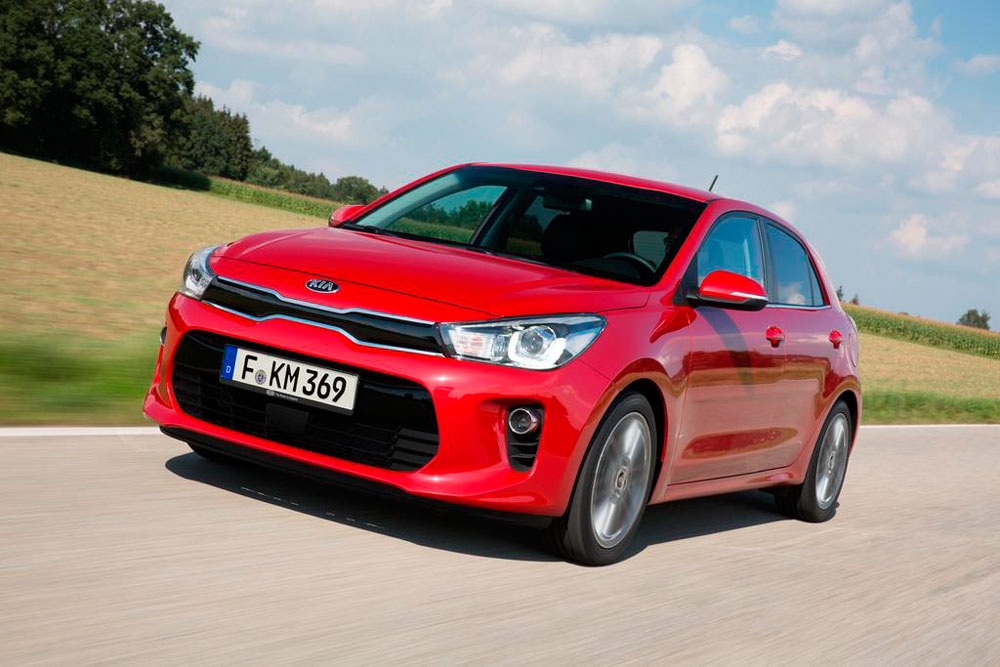
In 2003, Rio underwent a facelift that brought the car an improved design and brake system, which was often criticized in the past.
At the end of 2005, Rio 2 was shown. A hatchback version appeared for the first time. In 2010, the assembly of Rio began at Avtotor.
In 2011, the public was shown Rio 3, which after 6 months they began to assemble in St. Petersburg (successfully sold in Russia to this day).
By the way, an updated version of Rio is expected to be released soon - you can already get acquainted with spy photos and videos on the network.
The development of Renault Sandero began 5 years later, but the debut of the car was delayed by another 2 years. The debut version impressed fans with its merits and had a very good dynamics sales, including in Russia.
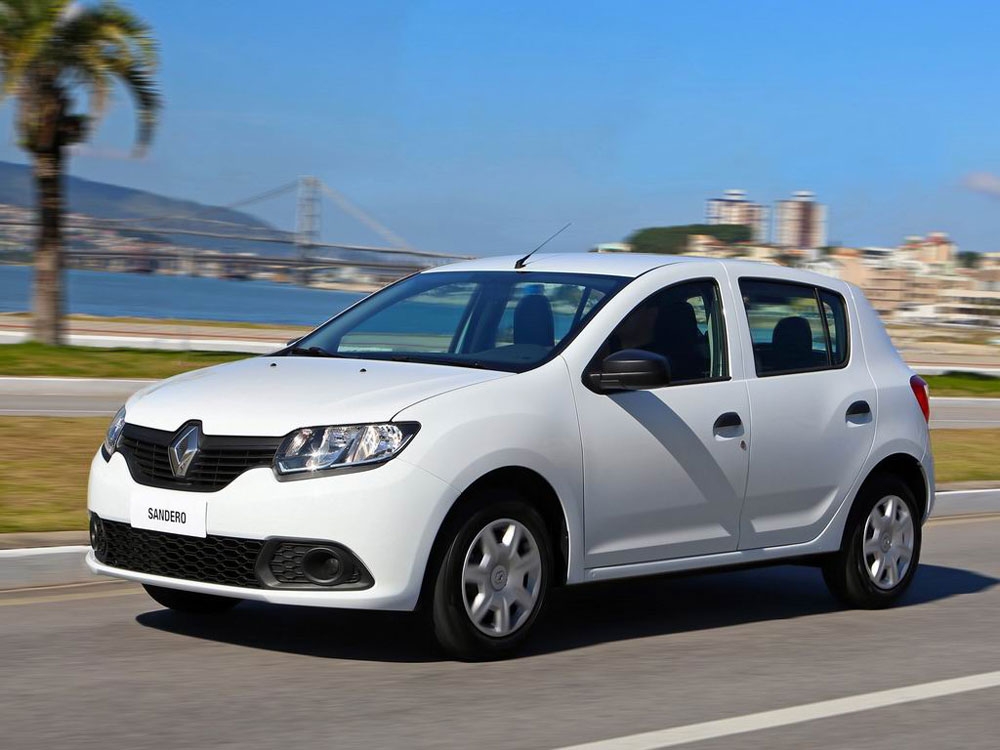
In 2012, the developers introduced Sandero 2, which no longer had anything to do with Logan, unlike previous version car. The new generation model, again, sold well in Russia, so the car.
In 2013, Renault Sandero was recognized as the best budget hatchback.
What to choose? If we proceed solely from the logic of numbers, then, of course, the “Korean” is the favorite here.
Specifications
For the most objective comparison, we chose two versions of 2017 hatchback cars, which are based on front-wheel drive platforms and are equipped with 1.6-liter gasoline engines. By the way, the power units of both Sandero and Rio are not very demanding on the quality of fuel and can easily work even on the 92nd.
In terms of power, things are as follows: the Sandero engine is capable of producing 105 horsepower, while Rio has 18 “horses” more. Not surprisingly, this greatly affects the dynamics. It takes 11.7 seconds to accelerate Sandero to hundreds, while Rio needs 10.3 seconds.
The biggest advantage of the Korean model is its efficiency - 5.9 liters on average, against. The French model is equipped with a four-speed "automatic", and Rio - 6 manual transmission.


Now let's talk about the dimensions: the body of Sandero is 105 mm shorter than Rio, but 64 mm higher than it. The wheelbase is also 17 mm longer for the French model. As for the height ground clearance, then here the Rio leader is 160 mm / 155 mm. We also note that Sandero is 46 kg heavier than his counterpart. But Rio has more trunk capacity - 389/320 liters.
Appearance
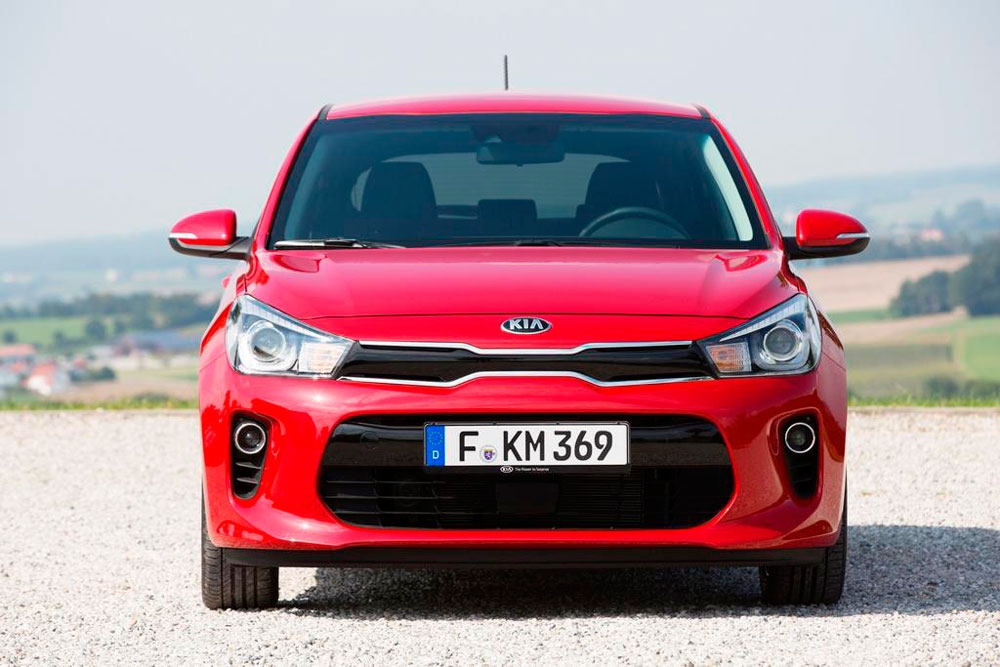
Outwardly, the cars are even somewhat similar, but it is still noticeable that different stylistic concepts were used in the design of their exterior. For example, external design Rio can offer solidity and conservatism, mixed with progressiveness and basic features model range. The exterior of the Sandero, on the contrary, looks expressive, and in some ways even resembles a crossover.
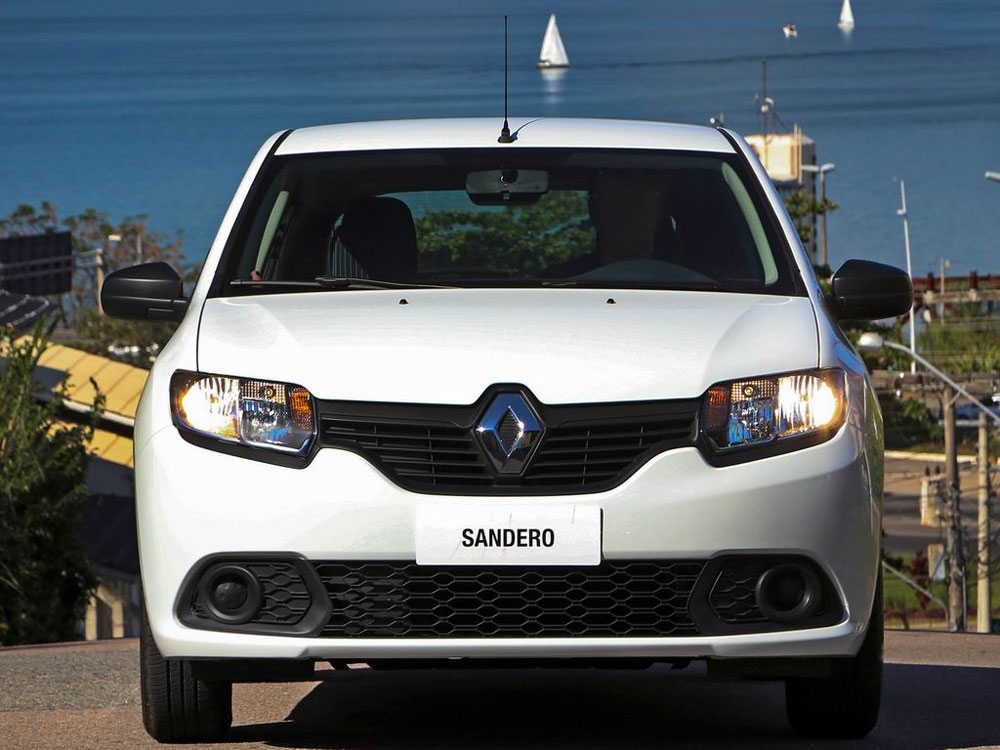
The front of the Rio is equipped with a wide "front" and a smooth hood, falling forward. The layout of these elements in Sandero is similar, except that the hood cover is more convex and voluminous. The nose of the Rio is equipped with a traditional false radiator and large LED headlights. Sandero can also answer this with a traditional false radiator grille and stylish headlamps.
The lower part of the Rio bumper is equipped with a trapezoidal air intake and a pair of rectangular foglights. Sandero has a wide air intake and oval foglights here.


On the side, there aren't too many differences between the cars either. The only thing I would like to note is the presence of sharp stampings on the profile surface of Rio, which Sandero does not have. If we talk about aerodynamics, then the Sandero body looks more streamlined.

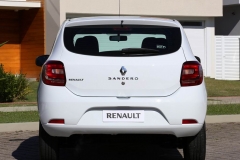
There are also no surprises at the rear, but because of the more stylish trunk lid and more powerful bumper, I want to give the victory to Rio.
Be that as it may, if you look at the picture as a whole, the exterior of Renault Sandero looks more attractive.
Salon

The interior of both cars is characterized by simplicity and conciseness. And if the Korean developers were still trying to give the interior of their car manufacturability, the French immediately made the main bet on minimalism.
![]()
The dashboard looks brighter and more informative for Renault Sandero. However, the Kia Rio has it turned towards the driver, which greatly simplifies the control process. The steering wheel looks better on the Kia Rio, as the manufacturers have equipped it with additional push-button controls.
1950 ViewsThe domestic market is quite saturated compact hatchbacks. And very often the buyer, trying to choose one of them for himself, must compare with each other approximately equivalent in characteristics and price category models. This situation can also happen with products. famous brands from South Korea and France, Kia Rio and Renault Sandero. Let's try to decide which car will be better for the Russian consumer.
Price
The beginning of the comparison should start with the cost of hatchbacks. It is noticeably different - Rio is more expensive by an average of 100-150 thousand, depending on the configuration. And this, in percentage, quite a lot - up to a quarter of the price of cars.
Engines
Renault Sandero offered to customers with 2 options for powertrains: 1.6-liter engines with a capacity of 82 and 102 hp. The first accelerates the car to 100 km / h in 12 seconds, consuming 9.0–9.8 liters per 100 km in the urban cycle. The second spends already 9.4-10.9 liters for the same distance, developing more power and providing acceleration to hundreds in 10.5 seconds. Modification with a 1.2-liter engine in 2015, the manufacturer decided to remove.
The Kia Rio model has a 1.4-liter engine with 107 hp. and a 1.6-liter engine at 123 horsepower. They spend, respectively, 8–8.5 and about 9 liters per 100 km, and accelerate to 100 km/h in 16 and 11 seconds.
Generally, Kia Rio has a more economical engine than the Renault Sandero. And its maximum speed is higher than that of the opponent - 190 km/h against 164-180 km/h (depending on modification). And here this car can be called the best, although not by much.
transmissions
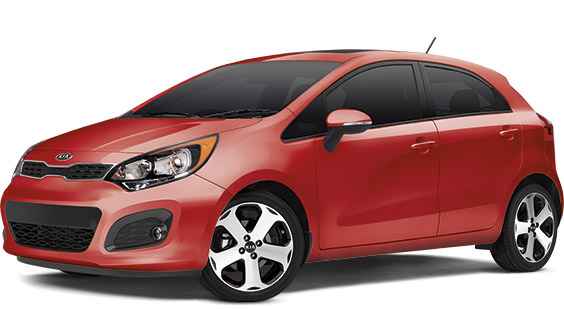 Sandero has three gearboxes to choose from - a 5-speed "mechanics", robotic box with the same number of gears and a 4-speed "automatic". The first is the only one available for the base Access package, while the rest are equipped with the middle and top version. This allows today to provide 9 different configurations, while in 2015 there were only 6 of them.
Sandero has three gearboxes to choose from - a 5-speed "mechanics", robotic box with the same number of gears and a 4-speed "automatic". The first is the only one available for the base Access package, while the rest are equipped with the middle and top version. This allows today to provide 9 different configurations, while in 2015 there were only 6 of them.
Rio manufacturers offer one of 2 boxes for the 1.4-liter unit: a 4-speed "automatic" and a 5-speed "mechanics". The latter is more reliable, and the former is more comfortable, although not very suitable for dynamic driving. A car with a 1.6-liter engine is equipped with 6 gears. There are a total of eight sets in the series.
Thus, in the transmission category, Kia Rio is almost on par with its rival. And there is no winner here. Although the robotic box provides certain advantages, it also costs more to maintain.
Appearance
 From the outside, the photos of the cars don't look too similar. Kia Rio has a more aggressive style, which is emphasized by a prominent radiator grille and elongated front optics. Half of the front bumper is occupied by an air intake, and along the edges there are original-looking “foglights”. The Kia Rio's profile is also stylish, and there are eye-catching taillights at the back.
From the outside, the photos of the cars don't look too similar. Kia Rio has a more aggressive style, which is emphasized by a prominent radiator grille and elongated front optics. Half of the front bumper is occupied by an air intake, and along the edges there are original-looking “foglights”. The Kia Rio's profile is also stylish, and there are eye-catching taillights at the back.
Sandero also looks good in the photo modern car. With its powerful air intake, it looks a bit like a competitor, but the “foglights” are already round, traditional for Renault, in shape. Renault body Sandero is quite proportional, and puffy wheel arches look just as good as .
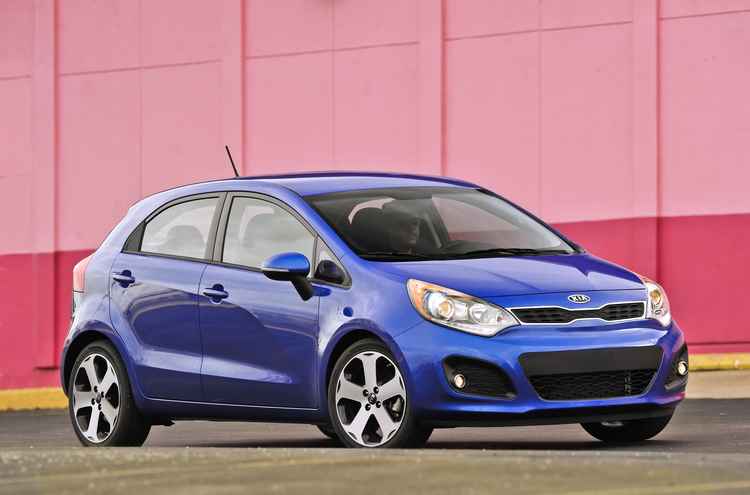 In general, according to Kia interior looks in the photo and up close more chic than the classic style of 2015 and earlier editions of Renault Sandero. Although the Frenchman cannot be called such a loser either - his style appeals to those who are used to the classics.
In general, according to Kia interior looks in the photo and up close more chic than the classic style of 2015 and earlier editions of Renault Sandero. Although the Frenchman cannot be called such a loser either - his style appeals to those who are used to the classics.
Interior
Comparing the interior design of the two hatchbacks is a little trickier. Firstly, because both salons look (in the photo and not only) well and ergonomically. Secondly, since the generation of 2015, Renault Sandero has changed markedly and received not only a comfortable wheel and an informative panel, but also quite high-quality plastic in the finish. Lateral support holds up quite well in corners, and the seats seem comfortable. At the same time, Renault will not be able to accommodate three people in the rear seats - the maximum number of passengers is 2.
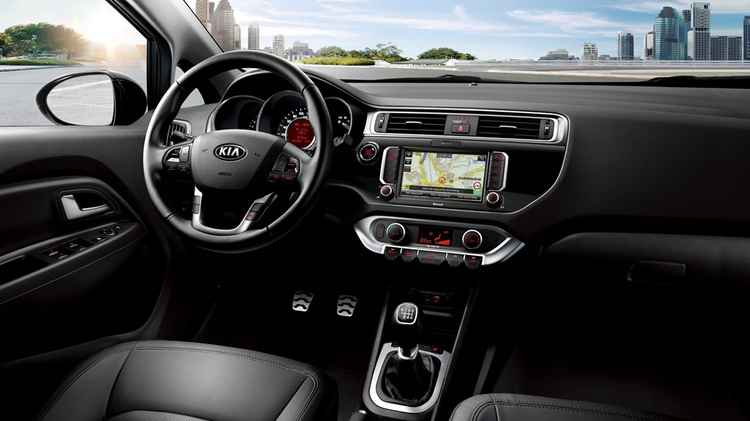 Salon at Rio is comparable to French. Although some moments look better - a bright panel, a stylish steering wheel, a good seat profile. But in the back row of the Kia Rio, it’s just as problematic for three to fit.
Salon at Rio is comparable to French. Although some moments look better - a bright panel, a stylish steering wheel, a good seat profile. But in the back row of the Kia Rio, it’s just as problematic for three to fit.
If we compare the cars according to the photo of the interior, we can say that both Renault and Kia performed well. And, if you look at this parameter, preference can be given to both one car and another.
Trunk capacity
According to the parameters of the luggage compartment, it goes ahead. It is able to accommodate up to 320 liters of cargo, which is important during long trips. And this capacity can be increased to 1200 liters if you fold the rear seats. True, the floor turns out to be uneven when folded, and the bumper does not have plastic pads to protect it from moving a heavy load.
Kia Rio has a very small cargo compartment - only 220 liters. But it is quite enough when the seats are folded - however, and here the loss to the “Frenchman” is noticeable, the volume increases only to 923 liters.
 According to the results of this category, we can say that Renault Sandero is more suitable for transportation. And, therefore, this model is preferable as a "workhorse" than its Kia competitor Rio.
According to the results of this category, we can say that Renault Sandero is more suitable for transportation. And, therefore, this model is preferable as a "workhorse" than its Kia competitor Rio.
Chassis
It is almost impossible to compare models by their suspensions. Since if the Kia Rio keeps well on the road with good quality surface, then Renault Sandero behaves here not too confidently, and even sways a little. At the same time, it is Renault Sandero that rides best on rough roads and off-road. And Kia Rio, on the contrary, makes it possible to feel all the bumps almost on yourself. But the suspension of the Korean hatchback is better and it is not in danger of swinging even at high speeds.
On this point, both models can also be considered equivalent. More precisely - suitable for the performance of their tasks. Someone needs a car for the city, someone - for uneven country roads. In the first case, this is Kia Rio, in the second, Renault Sandero.
conclusions
The results of the hatchback comparison were not entirely unambiguous. Kia Rio offers a stylish design (in the photo and "live") and good handling on flat roads. Renault Sandero is better in volume, off-road performance and, of course, in price. This means that consumers will buy both Kia and Sandero, depending on their needs.
